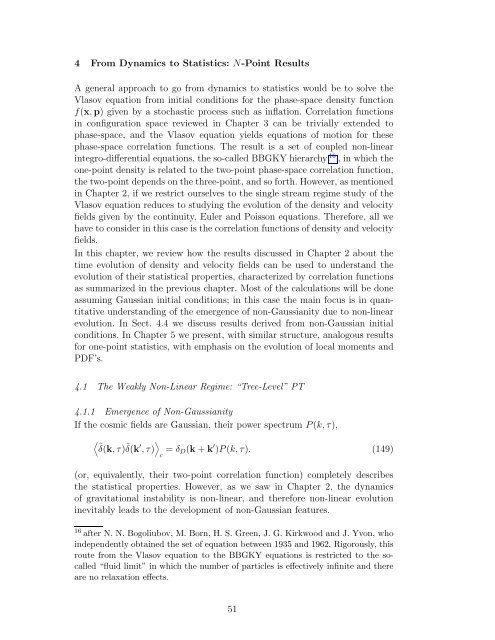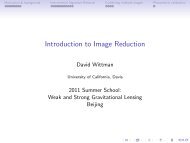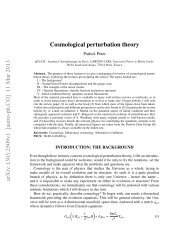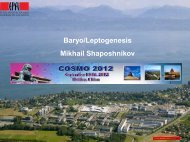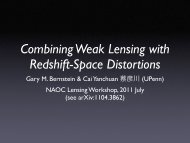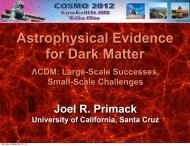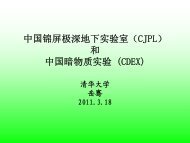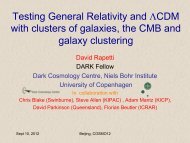Large-Scale Structure of the Universe and Cosmological ...
Large-Scale Structure of the Universe and Cosmological ...
Large-Scale Structure of the Universe and Cosmological ...
You also want an ePaper? Increase the reach of your titles
YUMPU automatically turns print PDFs into web optimized ePapers that Google loves.
4 From Dynamics to Statistics: N-Point Results<br />
A general approach to go from dynamics to statistics would be to solve <strong>the</strong><br />
Vlasov equation from initial conditions for <strong>the</strong> phase-space density function<br />
f(x,p) given by a stochastic process such as inflation. Correlation functions<br />
in configuration space reviewed in Chapter 3 can be trivially extended to<br />
phase-space, <strong>and</strong> <strong>the</strong> Vlasov equation yields equations <strong>of</strong> motion for <strong>the</strong>se<br />
phase-space correlation functions. The result is a set <strong>of</strong> coupled non-linear<br />
integro-differential equations, <strong>the</strong> so-called BBGKY hierarchy 16 , in which <strong>the</strong><br />
one-point density is related to <strong>the</strong> two-point phase-space correlation function,<br />
<strong>the</strong> two-point depends on <strong>the</strong> three-point, <strong>and</strong> so forth. However, as mentioned<br />
in Chapter 2, if we restrict ourselves to <strong>the</strong> single stream regime study <strong>of</strong> <strong>the</strong><br />
Vlasov equation reduces to studying <strong>the</strong> evolution <strong>of</strong> <strong>the</strong> density <strong>and</strong> velocity<br />
fields given by <strong>the</strong> continuity, Euler <strong>and</strong> Poisson equations. Therefore, all we<br />
have to consider in this case is <strong>the</strong> correlation functions <strong>of</strong> density <strong>and</strong> velocity<br />
fields.<br />
In this chapter, we review how <strong>the</strong> results discussed in Chapter 2 about <strong>the</strong><br />
time evolution <strong>of</strong> density <strong>and</strong> velocity fields can be used to underst<strong>and</strong> <strong>the</strong><br />
evolution <strong>of</strong> <strong>the</strong>ir statistical properties, characterized by correlation functions<br />
as summarized in <strong>the</strong> previous chapter. Most <strong>of</strong> <strong>the</strong> calculations will be done<br />
assuming Gaussian initial conditions; in this case <strong>the</strong> main focus is in quantitative<br />
underst<strong>and</strong>ing <strong>of</strong> <strong>the</strong> emergence <strong>of</strong> non-Gaussianity due to non-linear<br />
evolution. In Sect. 4.4 we discuss results derived from non-Gaussian initial<br />
conditions. In Chapter 5 we present, with similar structure, analogous results<br />
for one-point statistics, with emphasis on <strong>the</strong> evolution <strong>of</strong> local moments <strong>and</strong><br />
PDF’s.<br />
4.1 The Weakly Non-Linear Regime: “Tree-Level” PT<br />
4.1.1 Emergence <strong>of</strong> Non-Gaussianity<br />
If <strong>the</strong> cosmic fields are Gaussian, <strong>the</strong>ir power spectrum P(k, τ),<br />
˜δ(k, τ) ˜ δ(k ′ , τ) <br />
c = δD(k + k ′ )P(k, τ). (149)<br />
(or, equivalently, <strong>the</strong>ir two-point correlation function) completely describes<br />
<strong>the</strong> statistical properties. However, as we saw in Chapter 2, <strong>the</strong> dynamics<br />
<strong>of</strong> gravitational instability is non-linear, <strong>and</strong> <strong>the</strong>refore non-linear evolution<br />
inevitably leads to <strong>the</strong> development <strong>of</strong> non-Gaussian features.<br />
16 after N. N. Bogoliubov, M. Born, H. S. Green, J. G. Kirkwood <strong>and</strong> J. Yvon, who<br />
independently obtained <strong>the</strong> set <strong>of</strong> equation between 1935 <strong>and</strong> 1962. Rigorously, this<br />
route from <strong>the</strong> Vlasov equation to <strong>the</strong> BBGKY equations is restricted to <strong>the</strong> socalled<br />
“fluid limit” in which <strong>the</strong> number <strong>of</strong> particles is effectively infinite <strong>and</strong> <strong>the</strong>re<br />
are no relaxation effects.<br />
51


